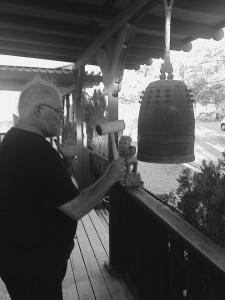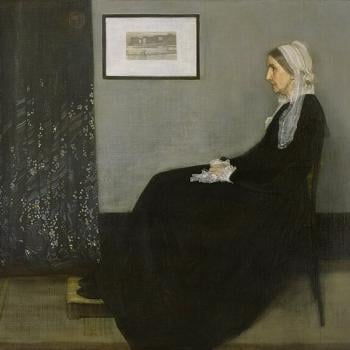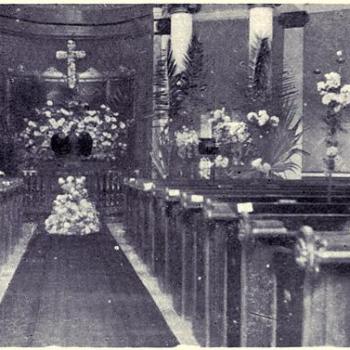Out on the inter webs someone asked the question “what are the central differences between Zen practiced in Asia and in the West.”
My old friend the ever thoughtful Stephen Slottow chose to respond.
“Some of the most salient, between Asia and the West? (1) Inclusion of women, (2) change of focus from monastic to lay practice, (3) along with (2), an increased emphasis on meditation outside of the training hall, along with a decreased emphasis on ritual (despite all of the complaints that there’s too much ritual), (4) far more decentralized organizational structures–there are little networks, but no large governing organizations, and (5) far less emphasis placed on merit. In Japan, the main societal function of Zen is the funeral business, rituals to gain merit for the dead, like praying for the intercession of saints in Catholicism. The societal function, mind you. That is almost completely absent in the West.”
I think he names it. While my personal experience is completely here in North America, my understanding of practice elsewhere in the West is for the most part sufficiently similar that I think he names it.
Here, in addition to sharing his list, I’d like to briefly expand a bit on these points.
1) One good thing about Zen from the beginning has been the rhetorical inclusion of women. A bad thing has been that this has been mostly a nominal acknowledgment. Women have historically been excluded, mostly within the Zen world reduced to unnamed tea ladies who ask pointed questions of aspiring monks and then point them on to real teachers. Zen in the West, well, it isn’t all peaches and cream for women, but my best estimate is that among the generally noticed teachers of Zen about half are women.
This is a significant feature of Zen in the West. And, I would go just a tad farther and say this also includes BGLTQ folk. Several of the most prominent of our contemporary teachers, and among the best teachers we can hope to find, are lesbians. And a wonderful thing is that within the Western Zen community this mostly passes unremarked. One’s sexuality is just one aspect about a particular teacher.
2) And I think there is some connection to the rise of lay practice. And, I note that the principal ordained model is Japanese bodhisattva ordained priests – who are not required to be celibate. And, along with that the rise in significance in the last decade of the Korean Taego order which also has non-celibate clergy. With this the locus of Zen practice has shifted for everyone from monastery to temple, center, and home. Even the clergy only experience monastic residence, if at all, as part of their formation. After which they live within the community. Here very few of the widely acknowledged teachers in the West are permanently resident monastics.
While I believe the monastery is valuable and hope we find ways to preserve this ancient aspect of our practice, the fact on the ground, a signal difference in focus is that emphasis on non monastic practice.
3) With this the emphasis on Zen’s meditation disciplines being accessible to everyone. In Asia for the most part practice is for professionals, the monastic community, or in Japan the clerics. Lay people are “hearers,” who listen to talks, who rely on the clergy for liturgical services (see 5). But, here in the West it is so common to be a lay practitioner there are serious conversations about what if anything is different between priests and lay practitioners.
4) The organized Vinaya monastic community is not in charge. There are Vinaya monks and nuns doing Zen, but the majority of practitioners and teachers are not. While the emerging Taego community maintains very close connections to its Korean organization this is not so for the Japanese derived lineages. The Soto Zen Buddhist Association, the American Zen Teachers Association, the Lay Zen Teachers Association, the White Plum Asangha, the Branches and Streams network of San Francisco Zen Center affiliates have limited sway over their members and none provide overarching understandings of what normative Zen in the West is supposed to look like.
For good and ill the individual lineage is the baseline for Zen in the West. This also means there is little accountability and no generally accepted standards for who is and who is not a Zen teacher or priest.
As far as Zen institutions are concerned we are definitely in a time of a hundred flowers.
5) The traditional work of the monastic and priestly communities beyond their spiritual disciplines has been as mediaries between the people and the fates, the gods, karma. This has only the most vestigial existence here in the West.
Many Zen practitioners in the West are in fact innocent of the centrality of this aspect of Zen in Asia.
Personally I think we have gone too far in this regard. It is my only major gripe about the forming of our Western Zen communities. Here, too often the shadow of our Western Zen communities is being little more than spiritual gyms, where we go, do our practices, and then leave. The result for this has been that Unitarian Universalists, Episcopalians and Reconstructionist Jews have picked up the spiritual community slack. In my view to our loss.
I, and I believe among others, are looking to a middle ground here. Being open to the widest range of interpretation about liturgy. Embracing liturgy and other celebrations of our cycles of life. Allowing us a place where our personal practices and our families and our larger communities of practice are integrated.













